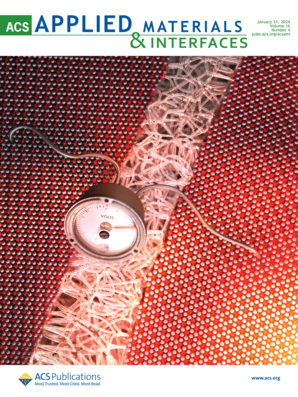Porous Hydrogel Electrolytes with Enhanced Ionic Conductivity for High-Power-Density Flexible Zinc-Air Batteries.
IF 8.3
2区 材料科学
Q1 MATERIALS SCIENCE, MULTIDISCIPLINARY
引用次数: 0
Abstract
Solid-state electrolytes are critical components in flexible zinc-air batteries, significantly influencing their overall performance. Traditional hydrogels, however, exhibit limited ion transmission rates, restricting their utility in these batteries. To address this issue, a porous hydrogel electrolyte composed of Polyacrylamide(PAM) and fabricated through SiO2 etching inspired by onion cell tissue was developed. The porous structure effectively absorbs substantial amounts of electrolyte, thereby minimizing ion transport resistance within the hydrogel electrolyte. This design enhances the ionic conductivity of the hydrogel to 350.2 mS·cm-1, achieving a peak power density of 155 mW·cm-2 and a prolonged operational lifetime of 62.6 h. During practical application, the battery demonstrates superior performance, underscoring the significant potential for advancing flexible zinc-air battery technologies.高功率密度柔性锌空气电池用增强离子电导率的多孔水凝胶电解质。
固态电解质是柔性锌空气电池的关键组成部分,对其整体性能有重要影响。然而,传统的水凝胶表现出有限的离子传输速率,限制了它们在这些电池中的应用。为了解决这一问题,受洋葱细胞组织的启发,开发了一种由聚丙烯酰胺(PAM)组成的多孔水凝胶电解质。多孔结构有效地吸收了大量的电解质,从而使水凝胶电解质内的离子传输阻力最小化。该设计将水凝胶的离子电导率提高到350.2 mS·cm-1,峰值功率密度达到155 mW·cm-2,使用寿命延长至62.6 h。在实际应用中,该电池表现出优异的性能,凸显了柔性锌空气电池技术的巨大发展潜力。
本文章由计算机程序翻译,如有差异,请以英文原文为准。
求助全文
约1分钟内获得全文
求助全文
来源期刊

ACS Applied Materials & Interfaces
工程技术-材料科学:综合
CiteScore
16.00
自引率
6.30%
发文量
4978
审稿时长
1.8 months
期刊介绍:
ACS Applied Materials & Interfaces is a leading interdisciplinary journal that brings together chemists, engineers, physicists, and biologists to explore the development and utilization of newly-discovered materials and interfacial processes for specific applications. Our journal has experienced remarkable growth since its establishment in 2009, both in terms of the number of articles published and the impact of the research showcased. We are proud to foster a truly global community, with the majority of published articles originating from outside the United States, reflecting the rapid growth of applied research worldwide.
 求助内容:
求助内容: 应助结果提醒方式:
应助结果提醒方式:


